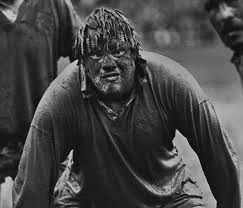The UK trainee perspective (The BJSM blog features the trainee perspective every two weeks)*
Guest blog by Dr Dee Clark

Over the time I have worked with Rugby Union teams, I have come across a number of methods for players dealing with their own skin “wounds”. These have ranged from use of safety pins, sewing needles (“sterilised” in a flame or just “off the shelf”) through to complicated use of homemade vacuum devices to draw out pus. Whilst this has been an educational experience (!), in my role as a team medic, and particularly as an ex nurse, it fills my heart with dread when presented with the aftermath of the self-treated or ignored wound. What often starts off as a relatively innocuous complaint, can lead to loss of training time, game time and even hospital admission.
Rugby is played on dirty surfaces. Training facilities can hide potential for infection disaster. The sharing of washing and drying areas and materials as well as the constant comings and goings of those being treated in physio and medical rooms have the potential to wipe out a team. Despite this, basic hygiene and common sense are often not employed in a strategy aimed at keeping players fit and healthy to play.
In one season we carried out an audit after noticing recurrent skin infections. It was shown that in the first half of the season 11 players from the squad needed formal treatment (antibiotics/ minor surgical procedures), with 6 losing training days and 3 losing game time. Further investigation led us to link the rise with a change in training facility where cleanliness had been an issue. After changing this facility, our infection rate decreased dramatically.
What we did to change things!
We reviewed facility cleaning arrangements, talked to the players about general hygiene including towel sharing, reporting of wounds, covering abrasions etc, installed more hand gel dispensers and instigated more stringent cleaning processes for physio and medical rooms.
Staff and players were encouraged to use hand gel and to wash their hands with greater frequency. Players were encouraged to report skin breaks at an early stage and were discouraged from self-treatment.
Sometimes, being swept up in the search for that extra 1% to make us bigger, better, stronger and faster than the others, can cause us to forget the basics. After all, an ounce of prevention is worth a pound of cure.
Articles of interest
Stacey A and Atkins B (2000) Infectious diseases in rugby players: incidence, treatment and prevention, Sports Med Mar; 29 (3) 211-220
Horgan M and Bergin C, IRB Policy on Hygiene, Infection control and Prevention of infection
Goodman R et al (1994), Infectious diseases in competitive sport, JAMA Mar; 271 (11) 862-867
***********************************************************
Dr Dee Clark is a Sport and Exercise Medicine Registrar and GP in the North West.
Dr James Thing co-ordinates “Sport and Exercise Medicine: The UK Trainee Perspective” which runs every two weeks.